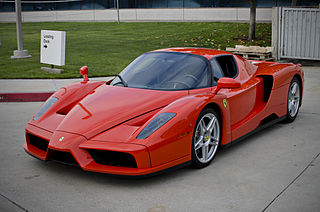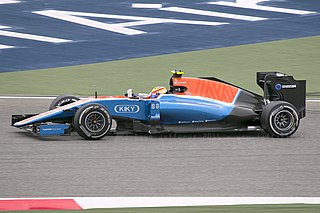
The McLaren F1 is a sports car designed and manufactured by British automobile manufacturer McLaren Cars and powered by the BMW S70/2 V12 engine. The original concept was conceived by Gordon Murray, who successfully convinced Ron Dennis to back the project and hired car designer Peter Stevens to design the exterior and interior of the car. On 31 March 1998, the XP5 prototype with a modified rev limiter set the Guinness World Record for the world's fastest production car, reaching 240.1 mph (386.4 km/h), surpassing the modified Jaguar XJ220's 218.3 mph (351 km/h) record from 1993.

The Ferrari Enzo, officially marketed as Enzo Ferrari, is a mid-engine sports car manufactured by Italian automobile manufacturer Ferrari and named after the company's founder, Enzo Ferrari. It was developed in 2002 using Formula One technology, such as a carbon-fibre body, F1-style automated-shift manual transmission, and carbon fibre-reinforced silicon carbide (C/SiC) ceramic composite disc brakes, as well as technologies not allowed in F1, such as active aerodynamics. The Enzo generates substantial amounts of downforce through its front underbody flaps, small adjustable rear spoiler and rear diffuser, which work in conjunction to produce 343 kilograms (756 lb) of downforce at 200 km/h (124 mph) and 775 kilograms (1,709 lb) of downforce at 300 km/h (186 mph), before decreasing to 585 kilograms (1,290 lb) at top speed.

The Ferrari F50 is a mid-engine sports car manufactured by Italian automobile manufacturer Ferrari from 1995 until 1997. Introduced in 1995, the car is a two-door, two seat targa top. The F50 is powered by a 4.7 L naturally aspirated Tipo F130B 60-valve V12 engine that was developed from the 3.5 L V12 used in the 1990 Ferrari 641 Formula One car. The car's design is an evolution of the 1989 Ferrari Mythos concept car.

In automotive engineering, a mid-engine layout describes the placement of an automobile engine in front of the rear-wheel axles, but behind the front axle.

The Ferrari 348 is a mid-engine V8-powered 2-seat sports car produced by Italian automaker Ferrari, replacing the 328 in 1989 and remaining in production until 1995, when it was replaced by the F355. It was the final V8 model developed under the direction of Enzo Ferrari before his death, commissioned to production posthumously.

The Ferrari 550 Maranello is a front-engine V12 2-seat grand tourer built by Ferrari from 1996 to 2002. The 550 Maranello marked Ferrari's return to a front-engine, rear-wheel drive layout for its 2-seater 12-cylinder model, 23 years after the 365 GTB/4 Daytona had been replaced by the mid-engined Berlinetta Boxer.

The Ferrari 599 GTB Fiorano is a grand tourer produced by the Italian automobile manufacturer Ferrari. It served as the brand's front-engined, two-seat model, replacing the 575M Maranello in 2006 as a 2007 model, and was later replaced for the 2013 model year by the F12berlinetta.
The Ferrari P was a series of Italian sports prototype racing cars produced by Ferrari during the 1960s and early 1970s.
The Ferrari 330 was a series of V12 powered automobiles produced by Ferrari in 2+2 GT Coupé, two-seat Berlinetta, spyder, and race car versions between 1963 and 1968. The name "330" refers to the approximate displacement of each single cylinder in cubic centimeters.

The Maserati Birdcage 75th is a functional concept car designed and developed by a Pininfarina design team led by Lowie Vermeersch, including Jason Castriota and Giuseppe Randazzo under the direction of Ken Okuyama. It was first introduced at the 2005 Geneva Auto Show. It was named to honor the classic Maserati Birdcage race cars of the 1960s and Pininfarina's 75th anniversary. The Birdcage was the result of a collaboration between Maserati, Pininfarina and Motorola to showcase their technical expertise. The car was completed in just 2 months, following a fast pace design phase using 3D renderings.

The Ferrari P4/5 is a one-off sports car made by Italian sports car manufacturer Ferrari but redesigned by Pininfarina for film director James Glickenhaus, son of stock exchange magnate Seth Glickenhaus.

LaFerrari, project name F150, is a limited production mid-engine, mild hybrid sports car built by Italian automotive manufacturer Ferrari. LaFerrari means "The Ferrari" in Italian; this is intended to be the definitive Ferrari.

The Ferrari F12berlinetta is a front mid-engine, rear-wheel-drive grand tourer produced by Italian automobile manufacturer Ferrari. The F12berlinetta debuted at the 2012 Geneva Motor Show, and replaced the 599 grand tourer. The naturally aspirated 6.3 litre Ferrari V12 engine used in the F12berlinetta has won the 2013 International Engine of the Year Award in the Best Performance category and Best Engine above 4.0 litres. The F12berlinetta was named "The Supercar of the Year 2012" by car magazine Top Gear. The F12berlinetta was replaced by the 812 Superfast in early 2017.

Flavio Manzoni is an Italian architect and automobile designer. He has been the Chief Design Officer at Ferrari since January 2010 and has led the creation of many Ferrari models, including the Ferrari F12berlinetta in collaboration with Pininfarina; the LaFerrari, the brand's first ever hybrid vehicle. In 2014 he was the recipient of the Compasso d'Oro for his work on the F12berlinetta project.

The Ferrari 488 is a mid-engine sports car produced by the Italian automobile manufacturer Ferrari. The car replaced the 458, being the first mid-engine Ferrari to use a turbocharged V8 since the F40. It was succeeded by the Ferrari F8.

The Ferrari 812 Superfast is a front mid-engine, rear-wheel-drive grand tourer produced by the Italian sports car manufacturer Ferrari that made its debut at the 2017 Geneva Motor Show. The 812 Superfast is the successor to the F12berlinetta.

The Ferrari SF90 Stradale is a mid-engine PHEV sports car produced by the Italian automobile manufacturer Ferrari. The car shares its name with the SF90 Formula One car with SF90 standing for the 90th anniversary of the Scuderia Ferrari racing team and "Stradale" meaning "made for the road".

The Ferrari Purosangue is a high-performance car by Italian automobile manufacturer Ferrari that was introduced on 13 September 2022. It is Ferrari's first production 4-door vehicle, and competes with high-performance SUVs such as the Lamborghini Urus and Aston Martin DBX.

The Ferrari 365 P Berlinetta Speciale was a concept sports car designed and produced by Pininfarina and Ferrari in 1966. It featured a mid-engined layout of a donor racing car chassis and three-seat arrangement with a central driving position, as later popularised on McLaren F1. It was the first purpose-built, mid-engined, road-going Ferrari-branded car. Other similar Ferraris at that time were road-usable race cars like the 1965 250 LM 'Speciale'.



















